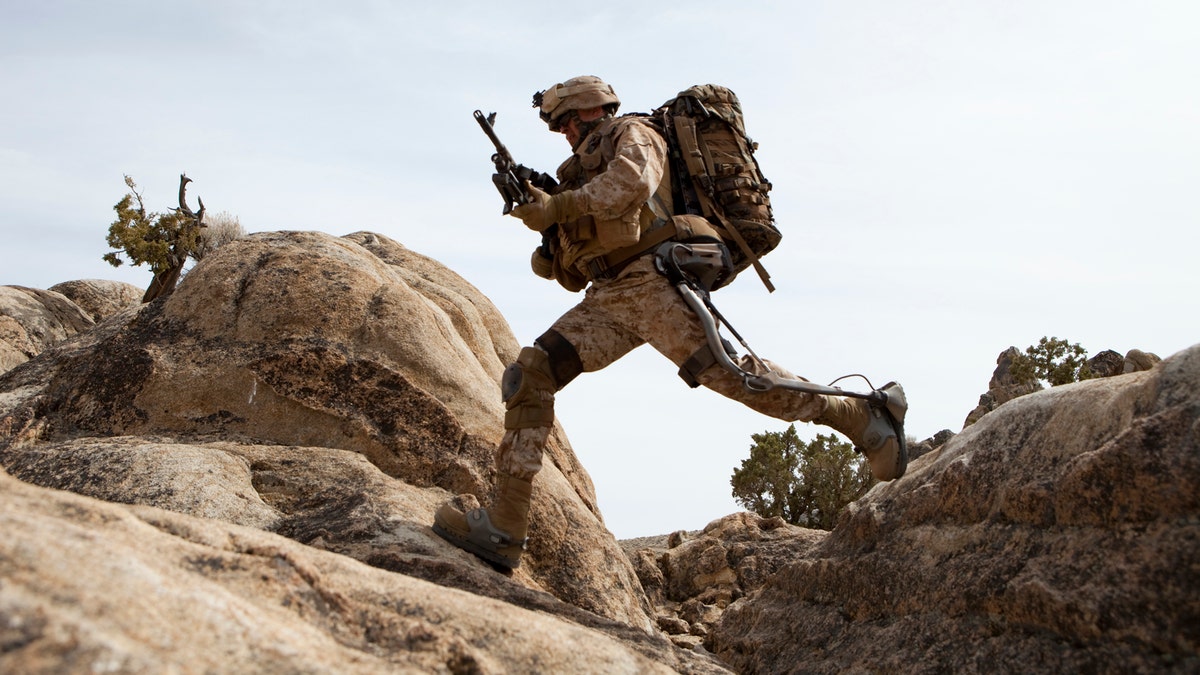
Lockheed Martin's HULC exoskeleton provides an energy boost for troops and helps prevent injuries during a battle. (HULC)
When you send young men and women to war, you owe it to them and their loved ones to keep them as safe as humanly possible. Or, in the 21st century, beyond-humanly possible. Here's a look at ten new technologies the military is exploring to keep U.S. troops safer, including robot drones, exoskeletons … and even chemical injections that deliver extra energy to soldiers.
1. Send in the 3D drones
Ashima Devices has developed a 3D surveillance technology for use with the company's ForceField drones. These small unmanned helicopters can be clipped to a soldier’s standard ALICE field-gear kit. When deployed, they provide a real-time, 3D view of the battlefield, including what's around a corner or rooftop, and can even simulate storming a building. The device uses a handheld computer to display the 3D view. A future enhancement will add thermal imaging, so troops can see heat signatures from weapons and vehicles.
2. Scanning for threats
A state-of-the-art video surveillance system in development can detect when enemies are on the move -- and analyze video feeds to see precisely when they are preparing to attack. Developed by Kitware, VIRAT (Video and Image Retrieval and Analysis Tool) scans video and identifies not only that there is a tank out there, but that it is driving down a one-way street or that troops have recently boarded. It then uses complex mathematical algorithms to warn troops of an impending attack. The system should be deployed in 2013.
3. Watching the instant replay
You might recognize the name Harris Corp.; the company worked with the NFL to develop the slow-motion technology that tracks Adrian Peterson’s touchdown runs for the Vikings. This year, the company started assisting the Pentagon with a “situational awareness” tracking system. It uses video from military drones and creates a log of battlefield threats -- and can even flag one particular enemy troop for closer analysis.
4. Shredding it up
The best defense is no longer a good offense -- it's a gnarly set of wheels. This all-terrain troop mover looks like a combination of a skateboard and a Segway scooter. Designed by BPG-WERKS, the DTV Shredder has a steering handlebar and rugged tracks that can help soldiers ascend a 40-degree ravine or rocket across a sandy escarpment at up to 30 mph.
5. Tagging the injured
Motorola has developed an ingenious tracking system for the Department of Defense that helps make sure hospitalized patients in a war zone get the proper medication. A radio-frequency (RFID) tag is embedded at each soldier’s bedside, and hospital staff use an RFID reader to make sure they have identified the soldier properly. The system also tracks medical equipment such as IV pumps and monitoring equipment.
6. Sending in Mosquitoes
Lantronix and Stara Technologies have jointly developed a battleground system called the Mosquito that intelligently delivers plasma packs, batteries, ammunition, food, and other supplies to battlefields. Lantronix developed the tracking database and telemetry transit system, which delivers GPS-guided containers developed by Stara that can weigh up to 150 pounds. The containers can be deployed from a C130 airplane, and can be sent to a precise spot on the battleground for a soft landing via a parachute.
7. Flying for days
Boeing recently announced the Phantom Eye drone, which has a 150-foot wingspan and is powered by two heavily modified Ford Ranger truck engines. The drone runs on hydrogen fuel and can stay aloft for up to four days -- much longer than most of the aerial drones used today. This alleviates tedious drone monitoring and the need for troops to constantly re-deploy fresh ones.
8. Breathing the air
Case Western Reserve School of Medicine is developing a chemical injection that will help troops adjust quickly to high altitude. Essentially an oxygen boost for troops who have hypoxia (low oxygen in the blood), the injection would take effect immediately and allow troops to carry out aerial missions and actually boost their energy for faster movement.
9. Staying out of the water
Wired reported recently about the Team Technologies Stingray, a device that shoots a tiny stream of water at thousands of feet per second -- it's like a water laser. The idea: A bomb defuser could use the device to disable roadside IED bombs by shooting a high-powered stream that splits the bomb apart into chunks without actually setting off the explosive.
10. Calling in the HULC
Lockheed Martin is developing the HULC exoskeleton, which provides an energy boost for troops and helps prevent injuries during a battle. The flexible exoskeleton allows troops to carry as much as 200 pounds of gear over rough terrain by supplementing their muscles. The device is modulated to align with body movements using an on-board computer chip, and allows the soldier to squat and crawl during combat.
